Conventional photoelectric conversion technologies generally use light-emitting devices such as LEDs. Such a light-emitting device mostly uses edge emission and is bulky, so it is difficult to combine with semiconductor technology. In the 1990s, the vertical cavity surface emitting laser VCSEL technology matured and solved the problem of the combination of light-emitting devices and semiconductor technology, so it quickly became popular.
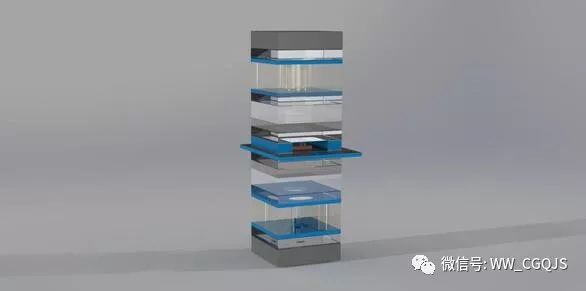
Two-sided emission vertical cavity surface emitting laser (VCSEL) in the middle of the wafer optical lens
VCSEL technology
Vertical-cavity Surface-Emitting Laser (VCSEL, also known as vertical cavity surface-emitting laser) is a kind of semiconductor, the laser is emitted perpendicular to the top surface, and is usually made of a separate chip. In the laser beam, the edge-emitting laser emitted from the edge is different.
VCSEL is a promising new optoelectronic device and a revolutionary light-emitting device in optical communication. As the name suggests, the edge-emitting laser emits in a direction parallel to the surface of the substrate perpendicular to the cleavage plane, while the surface-emitting laser has a light-emitting direction perpendicular to the surface of the substrate, as shown in the following figure:

Schematic diagram of edge emitting laser (a) and surface emitting laser (b)
It is superior to edge-emitting lasers in that it is easy to realize two-dimensional planar and optoelectronic integration; circular beam is easy to achieve effective coupling with fiber; high-speed modulation can be realized, can be applied to long-distance, high-speed fiber-optic communication systems; The size of the zone is extremely small, enabling high packing density and low threshold current; the chip does not need to be cleaved after growth, and can be subjected to on-chip experiments after packaging; it operates in a single longitudinal mode over a wide range of temperatures and currents; and the price is low.
The excellent performance of VCSEL has attracted wide attention and has become a hot spot in international research. Over the past decade, VCSELs have grown rapidly in structure, materials, wavelengths, and applications, and some products have entered the market.
VCSEL basic structure
The structure of the VCSEL is shown in the figure below. It consists of continuously growing single or multiple quantum well active regions between distributed Bragg reflectors (DBR) alternately grown from high and low refractive index dielectric materials. The typical number of quantum wells is 3~5, which are placed near the maximum of the standing wave field in order to obtain the maximum stimulated radiation efficiency and enter the oscillation field. A metal layer is also plated on the bottom to enhance the optical feedback of the underlying DBR, which is output from the top transparent window.
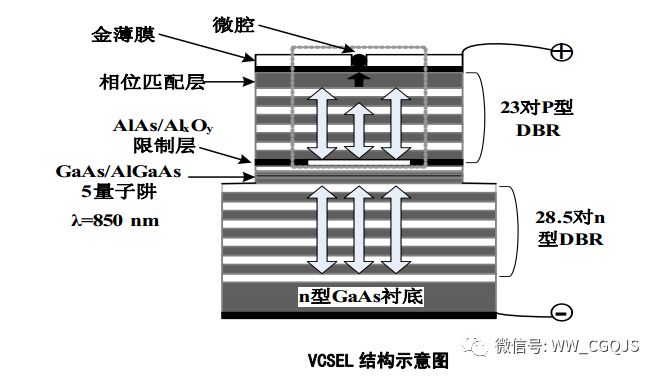
In fact, to perform low threshold current operation, as with a typical strip-type semiconductor laser, a strong current convergence structure must be used while performing light confinement and interception sub-constraint. As can be seen from the above figure, the semiconductor multilayer mirror DBR of VCSEL is composed of GaAs/AlAs, which is etched into an air-post structure. The AlAs layer is oxidized in the high-temperature steam to become an insulating AlxOy layer, and its refractive index is also greatly lowered, so that the light and the carriers are restricted in the vertical direction. The design of the VCSEL focuses on the high reflectivity, low loss DBR and the location of the active region within the cavity.
VCSEL laser features
Since the VCSEL has a different structure from the edge-emitting laser, this determines the different characteristics and performance between the two. The basic parameters of the two lasers are listed in the following table.
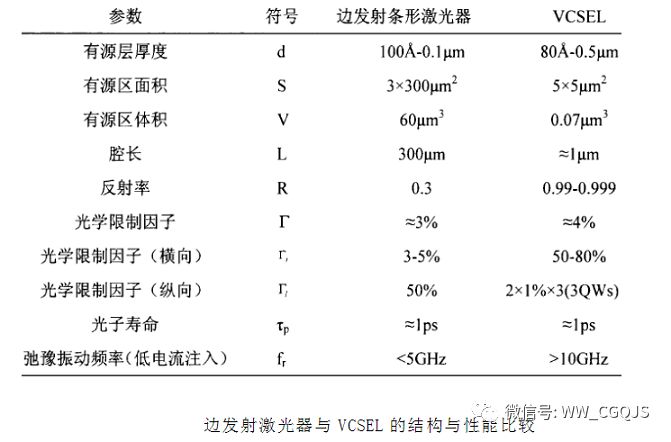
From the table we can see that the VCSEL active area is small in size and short in cavity, which determines that it is easy to achieve single longitudinal mode, low threshold (sub-mA) current operation, but in order to get a sufficiently high gain, The reflectivity of the mirror must be 99%. VCSELs have a high relaxation oscillation frequency, which is expected to have a wide range of applications in high-speed data transmission and optical communication. The VCSEL light-emitting direction is perpendicular to the surface of the substrate, which can achieve a good lateral light field limitation, perform a whole-chip test, obtain a circular beam, and easily produce a two-dimensional array. The epitaxial wafer can save production cost before the entire process is completed.
The main advantages of VCSEL are:
l. The outgoing beam is circular and has a small divergence angle, which is easy to couple with optical fibers and other optical components and is highly efficient.
2. It can realize high-speed modulation and can be applied to long-distance, high-speed fiber-optic communication systems.
3. The active area is small in size, and it is easy to realize single longitudinal mode and low threshold operation.
4. The electro-optic conversion efficiency can be greater than 50%, and a long device lifetime can be expected. 5. Easy to implement two-dimensional array, applied to parallel optical logic processing system, realize high-speed, large-capacity data processing, and can be applied to high-power devices.
6. The device can detect the chip before packaging, and carry out product screening, which greatly reduces the cost of the product.
7. It can be applied to a laminated optical integrated circuit, and a micro-mechanical technique or the like can be employed.
The history of VCSEL
The history of VCSEL is also the history of continuous optimization of its performance under the efforts of many scholars. In the past few decades, IGA and its team have played an indelible role. It can be called IGA professor as VCSEL. father.
With the many advantages of VCSEL, its application is more and more extensive. And in order to suit these applications, VCSELs are also developing in various directions, as shown in Figure 1, for their main applications:
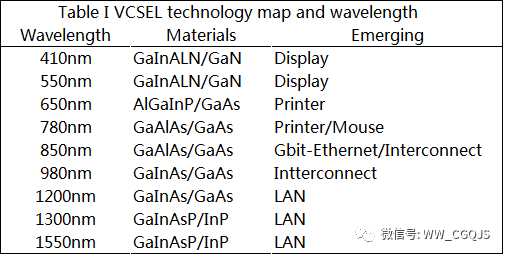
Different wavelength VCSEL applications
Since the current VCSEL is mainly used in optical transmission, based on the VCSEL of Soda et al. in 1979, the development of VCSEL has mainly gone through two stages:
The first stage: from the birth of VCSEL to the end of the 20th century, the stage of development.
At this stage, various organizations have proposed and tried VCSELs of various structure types, and finally the oxide-limited VCSELs have won many advantages.
In 1994, Huffaker et al. pioneered the use of in-situ oxidized AlGaAs under mesa to form a high-resistance layer of Al oxide to further limit the current. With this configuration, the threshold current can be reduced to 225 uA. This structure is the prototype of the currently widely used Oxide-confined structure;
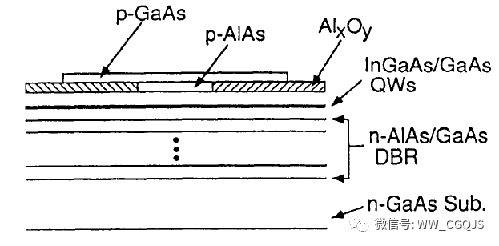
First oxide-limited VCSEL
In 2013, Iga gave a simple relationship formula for the key parameters of VCSEL such as threshold current, modulation bandwidth and active area:

The threshold current of a VCSEL is the same as that of other semiconductor lasers, and has the following relationship with the active area volume:
It can be seen from the formula that in order to reduce the threshold current, it is necessary to continuously reduce the volume of the active region. Comparing the current VCSEL with the active area volume of the strip laser, it can be found that the VCSEL has V=0.06um3 and the strip laser is still at V=60um3, which is why the threshold current of the strip laser is still typically tens of mA. Level, while the threshold current of the VCSEL has reached the sub-mA level.
The second stage: the gradual development of the mature stage and the optimization stage.
Since the oxide-limited VCSEL has many advantages such as a low threshold current, the VCSEL of this structure is quickly applied to optical communication.
Since the high operating current can bring better modulation characteristics, it also increases the power consumption accordingly, which in turn leads to an increase in temperature, which will affect reliability. Modulation rate and power consumption have become important challenges for VCSELs in the field of optical transmission. In 2007, YC.Chang et al. adopted a method of increasing the number of deep oxide layers to 5 layers and increasing the p-type doping concentration to reduce the series impedance. The 15 GHz modulation bandwidth achieved at 0.9 mA current, the corresponding power consumption is only 1.2 mW. The bandwidth/power ratio is only 12.5 GHz/mW, which is the most advanced level at that time. The VCSEL cross-section structure is shown in the figure:
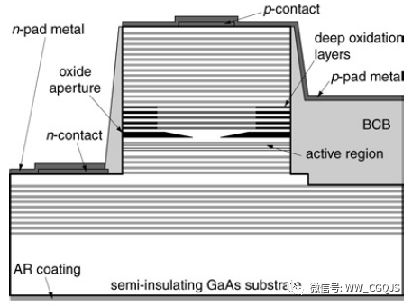
Deep oxide oxide limited VCSEL
Using the same VCSEL structure, in the same year, YC.Chang et al. realized 35 Gbps error-free transmission.
In 2011, Petter Westbergh et al. studied the relationship between photon lifetime of 850 nm oxide-limited VCSEL and resonant frequency and modulation rate, and pointed out that a compromise between high resonant frequency and low damping oscillation is used to increase the rate: when the photon lifetime is close to 3 ps. The modulation bandwidth of the VCSEL can be up to 23 GHz, and the error-free transmission of 40 Gb/s can be obtained at the same time.
In recent years, various interest groups have remained interested in high-speed, low-power VCSEL research. Figure 10 shows the results of various organizations as of 2015. It can be seen that if the pre-emphasis method is adopted, the current VCSEL back-to-back transmission can reach 71 Gbit/s.
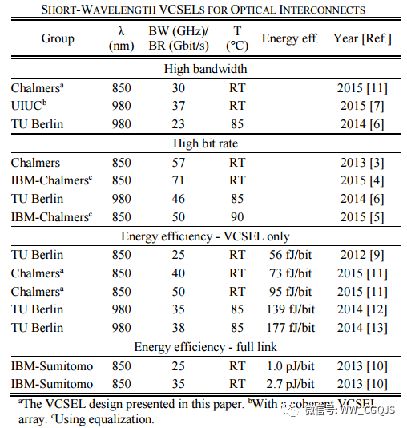
Recent developments in the field of short-wavelength VCSEL optical interconnects
The main application of VCSEL
1, for high-speed fiber optic communication
The 1300nm and 1550nm long-wavelength VCSELs have broad market prospects in Gb/s rate fiber-optic communication. Since the 1300nm and 1550nm wavelength VCSELs have the advantages of low dispersion and low attenuation window, they also have high-speed transmission in medium and long distance. Superiority
2, for digital communication
VCSELs will have a huge application market for short-range, high-capacity parallel data links. Low-cost and high-performance VCSELs are widely used for data transmission between nodes in a local area network. As LAN bandwidth requirements increase, G-bit Ethernet or high-speed LAN protocols are required, and VCSELs can be used as low-cost multimode optical transmitters;
3, for optical interconnection
The 1300 nm wavelength VCSEL is a key component in optical parallel processing, optical identification systems, and optical interconnect systems. VCSEL can fully utilize the parallel operation capability of photons and the advantages of large-scale integrated array in the fields of optical information processing, optical interconnection, optical switching, optical computing, neural network, etc., and has broad application prospects;
4, for optical storage
VCSELs can be used as optical storage read/write sources. The use of a VCSEL as a light source for a CD disc can increase the storage density, and the disc reading system can be equipped with a separate external photodetector to monitor the reflected light from the disc. The University of California, USA, has demonstrated a new integrated optical disc read head that uses a VCSEL with an internal cavity quantum well absorber. The CW beam emitted by the VCSEL is focused on the disc, and the expanded reflected beam enters the VCSEL cavity directly. Under reverse bias, the internal cavity absorber functions as a photodetector that produces a photo-generated current that provides an accurate optical feedback variable from the disc.
In addition, VCSELs are also used in new illuminators, displays, laser printers, and more.
The rapid development and inherent advantages of VCSELs have made them a key component in optoelectronic applications and have a strong vitality. In recent years, VCSELs with excellent performance have been continuously developed, mainly related to their low threshold current, high output power, high electro-optical conversion efficiency, low operating voltage, high modulation bandwidth and high yield. I believe that with the continuous development of VCSEL, it will gain more and more potential applications.
Defender Armor Phone Case,Armor Phone Case,Best Defender Armor Phone Case,Defender Armor Phone Case For Sale
Guangzhou Jiaqi International Trade Co., Ltd , https://www.make-case.com